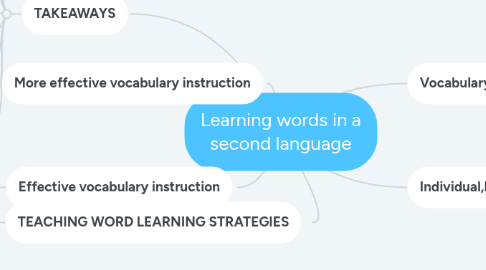
1. Effective vocabulary instruction
1.1. Shared book readings are extremely important for ELs
1.2. Independent reading provides ample practice and exposure to vocabulary
1.3. Incidental learning of vocabulary happens naturally when students read independently
1.3.1. Careful! Incidental learning is far more likely when students are reading books with accuracy, fluency, and good comprehension, in other words, "just right" books that they have personally selected
1.4. TELEVISION
1.4.1. Rich, education programs with subtitles are best
2. More effective vocabulary instruction
2.1. Some vocabulary instruction is better that none! Simply stating, copying definition
2.1.1. New node
2.2. Components that improve vocabulary instruction are
2.2.1. Definition
2.2.2. Context
2.2.3. Examples of use
2.2.4. Student use in language situations
2.2.5. Comparing contrasting to known words
2.2.6. Activation of prior knowledge
3. TEACHING WORD LEARNING STRATEGIES
3.1. 1. Use context to infer
3.1.1. Students must also have resources for finding out whether or not their inference is correct!
3.2. 2. Use word parts to infer
3.2.1. First languages usually have something similar to this, making it easier to connect
3.2.2. Can be tricky for young students with little or no understanding of affixes in any language
3.2.3. Morphology is proven very effective but should be accompanied by rich language instruction as well
3.3. 3. Teach dictionary use
3.3.1. ELs need to understand how to read a dictionary and its parts before this can be effective
3.3.2. Interpret definitions correctly
3.3.3. It is difficult for all students at early ages
3.4. COGNATE KNOWLEDGE
3.4.1. Powerful, especially when students can do it independently
3.4.1.1. Find their own
3.4.1.2. Watch out for and identify false cognates
3.4.1.3. Metacognition is highly practical and utilized
3.4.1.4. Using cognates can swing the advantage to ELs, they can use their expertise and this increases motivation
3.4.1.5. Can help students develop "word consciousness" and begin to revel in rich vocabulary use
4. TAKEAWAYS
4.1. Use prior knowledge
4.2. Encourage cognates and any connections to mother tongue
4.3. Front load on native language when possible
4.4. Allow for interpretation and expression in mother tongue
4.5. Use bilingual glossaries
4.6. Plan for vocabulary conversations among peers
4.7. Repetition and reinforcement are crucial for vocabulary permanence
4.8. Appropriate scaffolding and differentiation allow ELs to learn effectively in their zone of proximal development
5. Vocabulary learning task that students face
5.1. What is a word?
5.1.1. Words we here
5.1.2. Words we read
5.1.3. Words we speak
5.1.4. Words we write
5.2. Word families(same root)
5.3. Students learn around 3000 words each year
5.3.1. The 5,000 most frequent words make up 80% of school vocabulary
5.3.2. Teaching kids all the words in the vocabulary seems impossible, focusing on high frequency words seems doable

